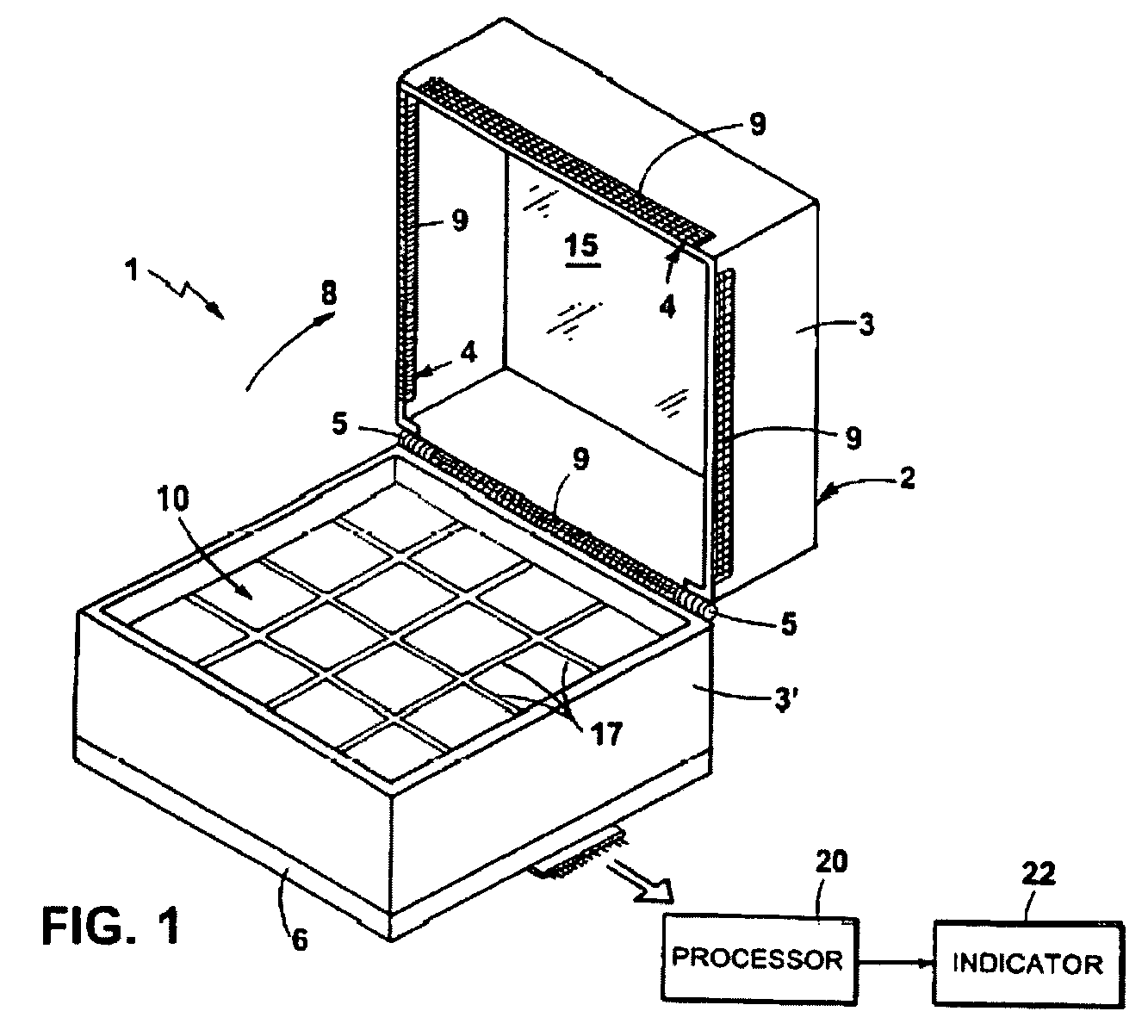Optoelectronic sensor
a technology of optoelectronic sensors and sensors, applied in the field of optoelectronic sensors, can solve problems such as increasing calcium concentrations, and achieve the effect of preventing device contamination
- Summary
- Abstract
- Description
- Claims
- Application Information
AI Technical Summary
Benefits of technology
Problems solved by technology
Method used
Image
Examples
example 1
Optoelectronic Device with Housing
[0037]Referring to FIGS. 1–3, a device 1 for detecting multiple airborne antigens includes a housing 2 having an upper half 3 and a lower half 3′ which together define an inner volume 18 (FIG. 3) of the device. When upper half 3 and lower half 3″ are together (closed position), they also define an opening 4 through which the antigen to be detected enters the device 2. An antigen-permeable mesh 9 is positioned over the opening 4 to prevent the ingress of large particles which could interfere with proper functioning of the inner components. The upper half 3 of the housing 1 is attached to the lower half 3′ by hinge 5, allowing the device 1 to be opened in a direction as indicated by arrow 8. Lower half 3′ has an open bottom to receive an optical detector, here a CCD 6, which is discussed in greater detail below.
[0038]The top view of the device 1 when the upper half 3 of the housing 2 is removed is shown in FIG. 2. The device 1 includes an array 10 of ...
example 2
Use of B Cells in an Optoelectronic Sensor
[0043]The ability of B cells to emit photons in response to an extracellular signal was evaluated. K46J B cells were loaded with the calcium-sensitive fluorescent dye indo-1, stimulated by contacting the loaded cells with anti-IgM antibodies, and monitored for fluorescence as follows.
[0044]About five million cells were removed from their growth medium and resuspended in 1 ml Hank's Balanced Salt Solution (HBSS). One vial of indo-1 was mixed with 113 μl of fetal bovine serum (FBS) and 25 μl of pluronic F-127 detergent (20% in DMSO). The mixture was incubated at room temperature for five minutes. The FBS was necessary to solubilize the indo-1, even though when the indo-1 was added to the cells, the FBS was capable of temporarily activating the cells.
[0045]After the five minute incubation, 40 μl of 100 mM probenecid was added to the cells to improve loading. Then 15 μl of the indo-1 mixture as prepared above was added. The cells were incubated ...
example 3
Use of Non-B Cells in a Optoelectronic Sensor
[0053]To determine if cell types other than B cells were appropriate for use in an optoelectronic sensor, the murine fibroblast cell line BALB / c 3T3 was evaluated as follows.
[0054]About 7×106 3T3 cells were removed from a confluent 10 cm2 tissue culture plate by trypsinization. These cells were then treated as describe above for K46J cells, except that 100 μl of fetal bovine serum was used to stimulate calcium mobilization instead of an anti-IgM antibody. Before and after stimulation, the fibroblasts exhibited a fluorescence ratio similar to that seen for K46J cells as discussed above, indicating that fibroblasts, as well as B cells, are suitable for the devices and methods of the invention.
[0055]As a further illustration that fibroblasts can be used in place of B cells in the invention, an in vitro aequorin luminescence assay was performed on aequorin produced in 3T3 cells, and the result compared to that of aequorin produced in K46J cel...
PUM
| Property | Measurement | Unit |
|---|---|---|
| temperature | aaaaa | aaaaa |
| pH | aaaaa | aaaaa |
| concentration | aaaaa | aaaaa |
Abstract
Description
Claims
Application Information
 Login to View More
Login to View More - R&D
- Intellectual Property
- Life Sciences
- Materials
- Tech Scout
- Unparalleled Data Quality
- Higher Quality Content
- 60% Fewer Hallucinations
Browse by: Latest US Patents, China's latest patents, Technical Efficacy Thesaurus, Application Domain, Technology Topic, Popular Technical Reports.
© 2025 PatSnap. All rights reserved.Legal|Privacy policy|Modern Slavery Act Transparency Statement|Sitemap|About US| Contact US: help@patsnap.com



